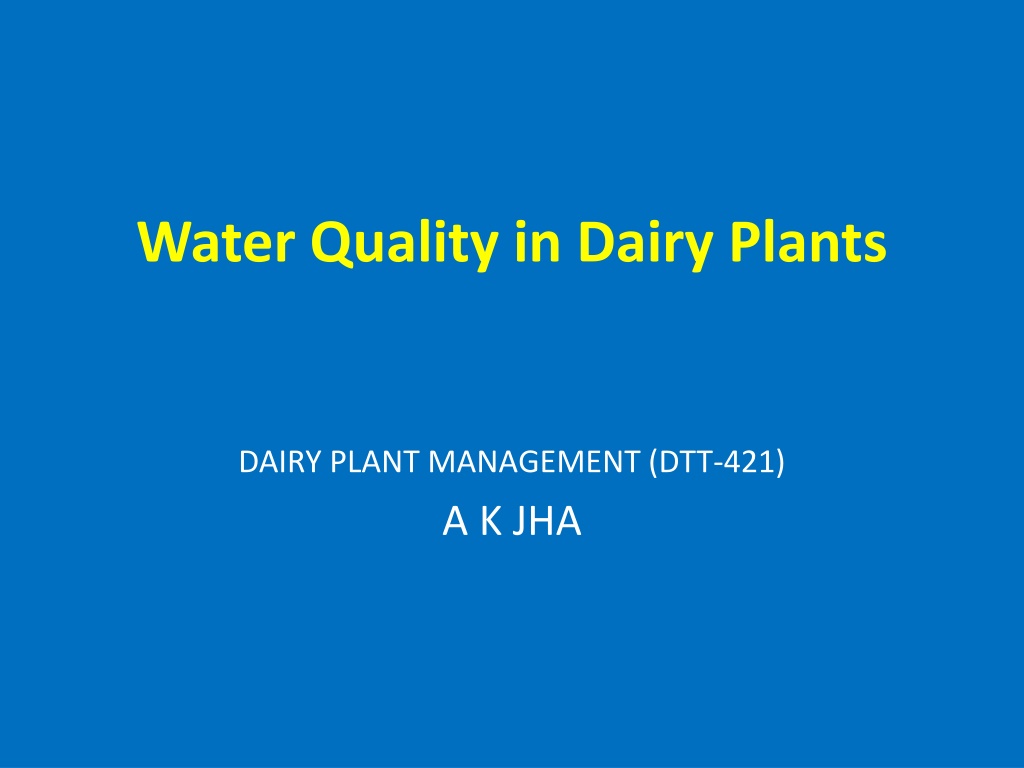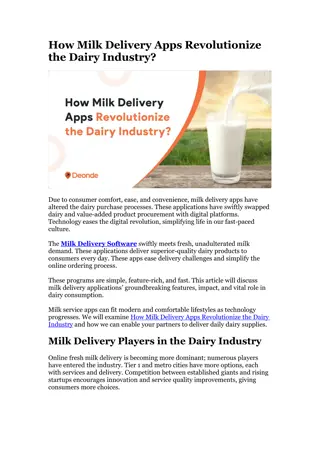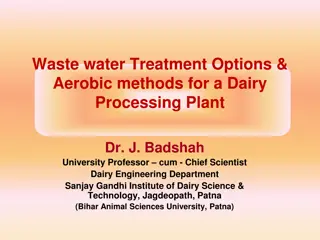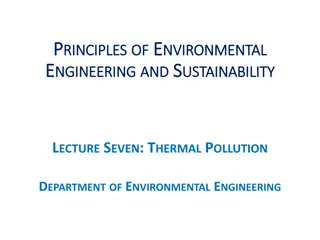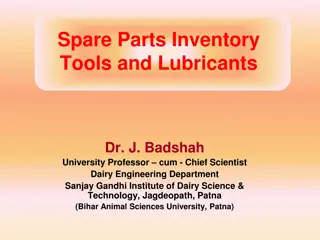Understanding Water Quality in Dairy Plants
Water quality plays a crucial role in dairy plant management. Impurities in water, including organic matter, dissolved gases, and mineral salts, can impact the overall quality. This article delves into the various aspects of water quality, such as dissolved and suspended matter, colloidal suspensions, and the purpose of purification for different uses. Furthermore, it discusses the effects of hard water on industrial processes like scale formation and corrosion.
Download Presentation

Please find below an Image/Link to download the presentation.
The content on the website is provided AS IS for your information and personal use only. It may not be sold, licensed, or shared on other websites without obtaining consent from the author. Download presentation by click this link. If you encounter any issues during the download, it is possible that the publisher has removed the file from their server.
E N D
Presentation Transcript
Water Quality in Dairy Plants DAIRY PLANT MANAGEMENT (DTT-421) A K JHA
Water Quality in Dairy Plants Impurities in water: Rain water is nearest approach of chemically pure water. But it contains small amounts of organic matter dissolved gases; principally O2 taken from the air. The composition of the ground over which and through which it flows after falling to the earth will determine the additional impurities that observe. The earth s surface contains large amounts of mineral salts such as carbonated, SO4 such as lime and Magnesia which are dissolved by water.
Water Quality for Dairy Plants Dissolved matter: The substances commonly found in solution are minerals, salts, gases. Suspended matter The suspended matter impurities include mud & sand, vegetable matter decayed, waste and sewage, bacteria. Amounts of impurities in water Calcium and Magnesium salts may be present in solution in amounts upto 800 ppm. Most natural water contain only relatively small amounts of Na salts, although some parts of country there are water with high contents with Sodium salts. CO2 is found in deep well water in quantities upto 40 ppm. Surface water ordinarily contain not more than a few ppm. Dissolved O2 is not usually present in deep well water but is found in surface water in amounts varying up to the limit of solubility which is about 14 ppm at 0 C.
Water Quality for Dairy Plants Colloidal suspensions This consists material of so finely divided that it cannot be seen under the microscope and existing in a state intermediate between true suspension and solution but removable by filtration. Matter in colloidal suspension does not settle out easily where ordinary suspended material will settle out with relative rapidity.
Water Quality for Dairy Plants Purpose of purification Municipalities purify water to make it suitable for domestic supply. Purification process is done to improve the visibility of water for their particular requirements including boiler feed. General domestic supply is desired to make water wholesome and safe for drinking and Object of purification is to remove the bacteria that causes disease, turbidity, colour, and odour which cause the water to be distasteful to the consumer . Industrial water supply & softening Softening occupies the most important place in industrial water supply. Although sedimentation, filtration, aeration, etc are frequently required as adjunct to the softening process. Hard water deposits scale in pipelines, boilers and cause economic loss.
Water Quality for Dairy Plants Effect of hard water Scale formation in pipelines and boilers that cause insulating effect which prevents transfer of heat Corrosion
Water Purification Methods Sedimentation Plain sedimentation The largest use and single method for removing impurities in water is plain sedimentation. The water is allowed to stand quite or move very slowly through artificial or natural basins until such of suspended impurities settled to water and the relatively clear water form on top. Dissolved impurities including the mineral salts cannot be removed but only the suspended matter can be removed. The degree of impurities removal depends on Length of the retention period Size of suspended particle Temperature of water (Higher the temp, faster the rate of settling) Sedimentation basins and size of suspended particles
Water Purification Methods Sedimentation contd.. Sedimentation intermittently. For operation, two or more basins are required. One is for standing and another is for withdrawal of the water. Plain sedimentation does not include chemical to any sedimentation to the water. The amount of turbidity by plain sedimentation will cover 60 to 70% for bacterial removal. Coagulation & sedimentation To reduce the retention period of the sedimentation bags and using smaller basins efficiently a coagulant chemical is fed to water as it enters. The coagulant reacts with alkaline salts, which are naturally present in the water and forms gelatinous precipitate which settles with relative rapidity and carried down with suspended matter with water. The most commonly added chemical is alum or aluminium sulphate. basins may be operated continuously or
Water Supply to Dairy An ideal water supply is one that is regular, adequate, soft cold and free from all impurities. The sources for water supply may be from wells, rivers, tanks and city water supply. About 4-5 liters of water is required per liter of milk handled depending on the type of plant before laying out the water supply system. Therefore, it is necessary to assess the qualitative requirement of water for the plant under consideration. The storage tank should be designed for about two days water requirement.
Water Supply to Dairy Water Requirements Dairy plants require large quantities of water for steam formation, heating and cooling processes, for cleaning and washing equipments and floors, etc. Refrigeration machinery requires about 2 gallons per minute per ton of refrigeration. Single stage condensing pans require about 2 to 3 gallons of water per pound of water evaporated. Cooling of milk requires a ratio of 3:1, 3 parts of water to 1 part of milk. Can washing approximately 2 gallons of water per can is needed. Water is needed for washing equipment which may be from 20 to 50 gallons per 1000 pounds of milk.
Treatment of Hard Water Hard water contains calcium and magnesium salts in solution as carbonates and sulphates. Hard water is not suitable for washing as it won't give froth with soap and is also unsuitable for cooling and for some of the industries. Therefore, hard water requires treatment before use. In a tank of hard water, proper proportion of milk and lime is added and stirred with mechanical stirrer and allow settling and the clear water is pumped out and then the tank is washed and the process is repeated. This is an intermittent system, but there will be water softness where the system is a continuous one.
Treatment of Hard Water Reutilization of water Large quantities of water are required for removing the heat from certain equipments e.g. refrigeration, compressors, milk condensing units, etc. Practice of reutilization of the same water is good. but, to utilize the water, cooling of the water to the desired temperature is essential. spray ponds and tower coolers are very helpful for this purpose.
Standards for Water in a Dairy Plant As per BIS (IS : 425), the water to be used in a processed food industry should not have Coliform more than 1 / 100 ml and SPC more than 50 / ml. Water should also be free from thermophilic organisms. Chilled and hot water are free from these requirements. The hardness of water which is used in dairy should have less than 10 ppm of calcium carbonate.
Bacteriological Standards for Dairy Plant Water Quality Quality Total Colony Count/ml 220 C 370 C Satisfactory Doubtful 100 100 10-100 100-1000 Unsatisfactory 1000 100 On the basis of these standards, the dairy can decide which kind of treatment is needed for its water supply. This is very helpful in determining the water quality of a plant and what preventive or control measures to be taken to tackle the problem.
